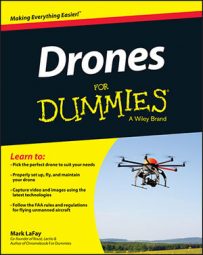The best weather for drone flying is when it is sunny, a reasonable temperature (75 degrees Fahrenheit, for example), and little to no wind. The reasons for this are simple: sunny days are beautiful, 75 degrees is simply the perfect temperature, and flying in the wind is a pain in the rear. Besides being a more enjoyable experience, there is some science to flying in mild temps.
Flying in wind can be difficult and will drain your drone battery faster than normal. Cold temps cause batteries to lose charge faster. Rain is detrimental to anything electronic and high heat isn’t because drones produce quite a bit of heat on their own. Extreme heat can put unnecessary wear and tear on batteries and computers.
But the reality is that you will probably want to fly in weather conditions that don’t always fit this profile. Flying on cloudy days or days that are hot or cool aren’t so much a problem. It’s the days that are freezing, precipitating, or extremely windy that are particularly troublesome.
Rain and snow
Flying in precipitation is a surefire way to ruin your drone for good. It goes without saying that water and electronics don’t mix. Most drones are not waterproof, or water resistant. Think of your drone as being the Wicked Witch of the West. A little bit of water is going to bring your drone to a dramatic end. A good policy to have is that if it is raining, even just misting, you should keep the drone bundled up inside and away from its arch nemesis.
Flying a drone in snow is not as bad of an idea as flying in rain, but it can still result in damage to your drone. Flying in snow is great because it makes for great pictures and video. However, flying in snow is difficult for some drones that utilize cameras for stability and navigation. This is because the white snow provides little to no contrast for the cameras to discern movement.
Whether the snow is falling from the sky and onto a drone that’s airborne, or if your drone crash lands into a pile of the white fluffy stuff, snow is not friendly to drones.
Having reduced control of your drone in a snowy landscape could equal disaster for your drone. Snow is nothing more than frozen water, albeit pretty frozen water, and when snow hits warm batteries and motors, it melts and now you’re looking at potentially saturating your electronics and killing your drone.
If you crash your drone in the snow, remove the battery immediately and use a towel to wipe it off. Snow that makes its way into your drone can be blown out with compressed air. The key is to make sure there is no power connected to your drone if it has been exposed to water.
Windy days
Usually with precipitation comes wind, but not always. If you live in Chicago, wind is a normal occurrence and more often than not it isn’t accompanied by rain, sleet, or snow. You can fly a drone in wind but if it gets much stronger than 20 mph, you drone will be cruising for a bruising.
Flying in wind requires a lot of practice, patience, and back up batteries. Your drone will blaze through batteries trying to maintain any sort of position on a windy day. If you plan to fly on a windy day, watch the batteries and the buildings.
Freezing temperatures
A lesser known environmental hazard is freezing temperatures. This seems counterintuitive because the battery and moving parts on a drone can get quite warm when in use. But the reality is that Lithium Polymer batteries, which are the common battery of choice in drones, drain substantially faster in freezing cold weather. A beautifully sunny winter day with no wind can be a wolf in sheep’s clothing so be sure to closely monitor your battery life when flying on a cold day.

